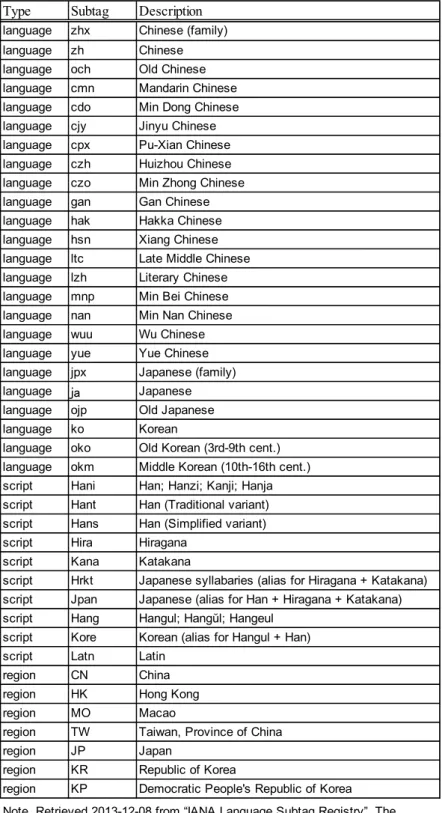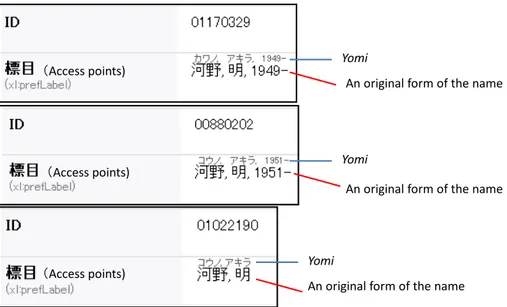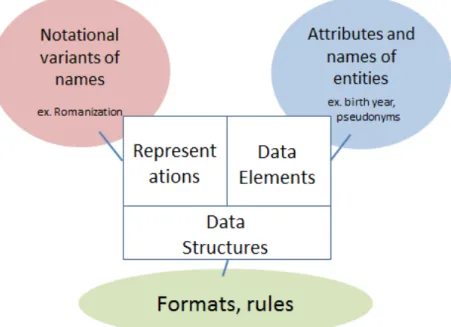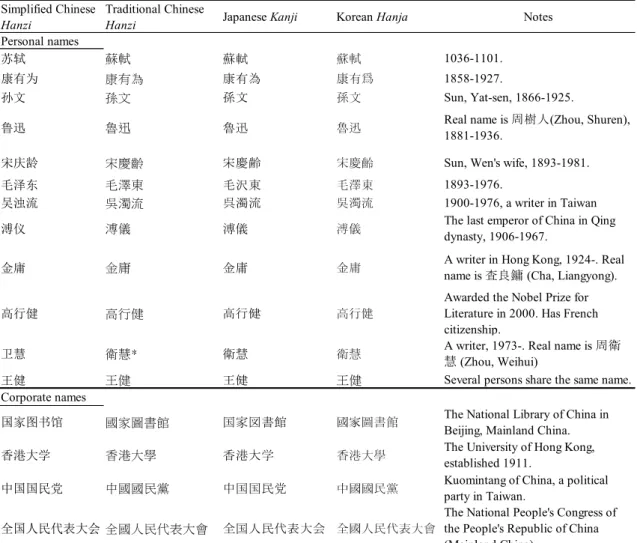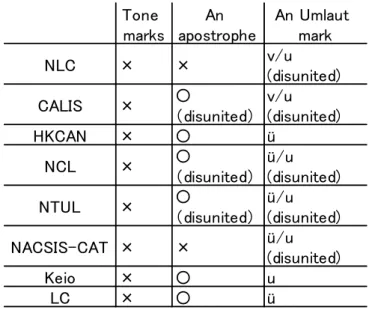Kanji o chushin to shita hiromaji hyoki ni yoru meisho tenkyo deta to sono moderu kochiku
Teks penuh
(2) Abstract Recently, the importance of authority control and sharing authority data has been increasingly appreciated. However, attempts at sharing authority data internationally have been conducted mainly within Western countries. Sharing name authority data in all languages, including non-Latin languages, is an ideal but yet insurmountable goal for library communities. Moreover, the authority data recorded by organizations in non-Latin alphabet countries are diverse, and their differences have not been investigated or clarified in full detail. Taking such differences into account for sharing authority data will help us to achieve more accurate matching results. The purposes of this study are to 1) investigate representations and data elements recorded in name authority data constructed by organizations located in the Chinese character cultural sphere and by the Library of Congress for a comparison; 2) based on the above analysis, develop an authority data model that can address complicated representations of non-Latin languages; and 3) propose authority data formats that use the developed model in actual authority data and authority works. In Chapter 1, trends of global authority control and issues of non-Latin representations in such global authority control are explained, and the purpose of the study is provided. Related works and existing authority data models including FRAD, MARC 21 Authority Format, RDA, and DCMI Abstract Model are reviewed in Chapter 2. The review reveals that these models are equally insufficient to handle complex representations of non-Latin languages. In Chapter 3, a new framework of name authority data that includes representations, data elements, and data structures is proposed for subsequent analysis. Characteristics of personal names in the Chinese character cultural sphere are overviewed in the first half of Chapter 3 as a basis of the framework. In Chapter 4, research methods and research objects are explained first, and then current practices and policies of authority control in China, Japan, South Korea, and Vietnam are described mainly based on interviews. The research methods involved data collection that included face-to-face interviews and collection of cataloging rules, formats, and manuals about name authority data from each organization. Search results of authority databases or OPACs of each organization were also consulted if available. After these data were collected, checkpoints that are unique to Japanese, Chinese, Korean, and Vietnamese name authority data were set. Based on the gathered information, the checkpoints were investigated, taking into account the comparison of the current practices of each organization, and issues affecting data sharing were identified. For Vietnamese names, interviews were not conducted and limited institutions were investigated. Therefore, the research method for Vietnamese names is explained separately in Chapter 8. As the checkpoints and search terms used to search the authority databases or OPACs i.
(3) of each organization differed by language, they are explained in Chapters 5–8, respectively. The results about the representations of Chinese, Japanese, Korean, and Vietnamese name authority data recorded in the Chinese character cultural sphere are shown in Chapters 5–8, respectively. It was revealed that Chinese character forms are recorded in letter types that are used by each region where each organization is located. This means Chinese character forms are not always “accurate” forms that the person or corporate body uses in its native country. Romanized forms of Chinese names are recorded using Hanyu Pinyin in all organizations investigated except the ones in South Korea. However, the handling of umlauts differs by organization, and this may be an obstacle to string matching based on Romanized forms of Chinese names. Romanized forms of Japanese names, on the other hand, might vary by organization because the Hepburn Romanization system adopted by each organization is slightly different. Furthermore, as Romanization systems adopted by organizations in South Korea and other countries are different, Romanized forms of Korean names may differ among organizations as well. These results show that identifying CJK names merely using the Romanized forms used by organizations is difficult. In addition, despite the importance of yomi for Japanese names, it is not recorded by organizations outside Japan, and thus, yomi cannot be used for identifying Japanese names when authority data are shared among several organizations. Similarly, organizations outside South Korea do not record Hangul forms of Korean names as a mandatory element. This may preclude the possibility of identifying Korean names using Hangul forms across organizations. In Vietnam, name authority control for author names was even not conducted. In summary, any single type of representation is insufficient as a master key for name identification when name authority data are shared. Rather, the combination of several representations seems to be helpful for name identification. In Chapter 9, the data elements recorded by each organization were examined and compared to authority data elements defined in RDA. It was ascertained that core elements defined in RDA were recorded by most organizations. Among non-core elements, field of study, lineage (especially in Japan), gender, place of ancestry (especially in China), nature or character, and history were recorded by many organizations. RDA defines that some data elements should be recorded separately from access points. These elements are, however, recorded as additions to access points in Japan and China. Based on the above results, a modification of the FRAD model is proposed in Chapter 10. In the presentations, three kinds of representations, namely, non-Latin transliteration, non-Latin transcription, and Romanization, were defined. Introducing the parent-child relationship into Control Access Points made it possible to determine which two representations should be shown as a pair in authority data. Chapter 11 describes the development of two authority data formats, namely, modified MARC ii.
(4) 21 Format for Authority Data and RDF/XML format, which can adopt the modified FRAD model proposed in Chapter 10 to authority data. Chapter 12 summarizes the overall results of the study.. iii.
(5) Acknowledgements I would like to express my special appreciation and gratitude to Shunsaku Tamura, Emeritus Professor at the School of Library and Information Science, Keio University, who has been an important mentor of mine since I was an undergraduate student. After Prof. Tamura retired in March 2015, Professor Dr. Shoichi Taniguchi became my supervisor. I deeply appreciate his kind acceptance of this role and valuable comments on my dissertation. I would also like to thank Dr. Barbara B. Tillett, who provided me with excellent comments and suggestions on my first English paper, which is a basis of Chapter six of this dissertation, and on several other chapters. I would also like to acknowledge the library staff I interviewed in the six regions I visited. All of them kindly agreed to participate in my research interviews and provided me with sample data for this research. I would also like to thank the professors in Keio and other institutions who introduced me to each library’s relevant contact person for conducting interviews. Parts of this research were financially supported by the Mita Society for Library and Information Science (FY 2012), the Kobayashi Fellowship Program from The Fuji Xerox Setsutaro Kobayashi Memorial Fund (FY 2013), the Sasagawa Scientific Research Grant from The Japan Science Society (FY 2014), and Japan Society of Library and Information Science (FY 2015). A special thanks to my family. Words cannot express how grateful I am to my mother and father for all of the sacrifices that they’ve made on my behalf. Finally, I would like express my appreciation to my beloved husband Takushi, who always supported me in difficult moments, and to our daughter Kureha, who happily began to go nursery when she was three months old..
(6) Table of contents Chapter 1 Introduction ............................................................................................................ 1 1.1. Authority control in a global environment .................................................................... 1. 1.2. Issues in non-Latin representations in global authority control ....................................... 4. 1.3. Purpose of the study.................................................................................................... 5. Chapter 2 Literature review ..................................................................................................... 9 2.1. History of rules and standards of authority control ........................................................ 9. 2.2. Authority control of names in non-Latin languages ..................................................... 13. 2.3. Writing systems in the Chinese character cultural sphere and its handlings in Western. authority data ...................................................................................................................... 17 2.4. Current conceptual models of authority data in non-Latin script languages and their. inadequacies ....................................................................................................................... 20 2.4.1. FRAD model .................................................................................................... 20. 2.4.2. Model A and Model B of MARC 21/A ................................................................ 23. 2.4.3. RDA model....................................................................................................... 26. 2.4.4. DCMI Abstract Model ....................................................................................... 27. Chapter 3 Framework of name authority data ......................................................................... 40 3.1. Characteristics of personal names in the Chinese character cultural sphere .................... 40. 3.1.1 3.1.1.1. Current Chinese names .................................................................................. 40. 3.1.1.2. Romanized representations of Chinese names .................................................. 41. 3.1.2. Japanese names ................................................................................................. 42. 3.1.2.1. Current Japanese names ................................................................................. 42. 3.1.2.2. Romanized representations of Japanese names ................................................. 45. 3.1.3. Korean names ................................................................................................... 45. 3.1.3.1. Current Korean names ................................................................................... 45. 3.1.3.2. Romanized representations of Korean names ................................................... 47. 3.1.4 3.2. Chinese names .................................................................................................. 40. Vietnamese names ............................................................................................. 48. Representations, data elements, and structures ............................................................ 49. Chapter 4 Method and research objects ................................................................................ 57 4.1. Method .................................................................................................................... 57. 4.1.1. Organizations studied ........................................................................................ 57. 4.1.2. Step 1 – Data collection ..................................................................................... 58. 4.1.3. Step 2 - Setting checkpoints that are unique to authority data of each area ............. 62. 4.1.4. Step 3 - Identification of issues affecting data sharing .......................................... 62 i.
(7) 4.2. Current practices and policies of authority control in each area .................................... 62. Chapter 5 Representations of Chinese name authority data in Chinese character cultures ...... 72 5.1. Checkpoints and search terms .................................................................................... 72. 5.1.1. Checkpoints ...................................................................................................... 72. 5.1.2. Search terms ..................................................................................................... 73. 5.2. Adoption and character forms of Chinese characters ................................................... 73. 5.3. Treatments and types of Romanization ....................................................................... 77. 5.3.1. Treatments and types ......................................................................................... 77. 5.3.2. Adoption of Tone Marks, Apostrophes, and Umlaut Marks with “U” ..................... 80. 5.4. Separation of surname and given name with a comma ................................................. 82. 5.5. Representations in local languages outside China, Hong Kong, and Taiwan .................. 83. 5.6. Discussion: differences in representations and problems to be solved ........................... 86. Chapter 6 Representations of Japanese name authority data in Chinese character cultures..... 90 6.1. Checkpoints and search terms .................................................................................... 90. 6.1.1. Checkpoints ...................................................................................................... 90. 6.1.2. Search terms ..................................................................................................... 91. 6.2. Adoption and character forms of Chinese characters ................................................... 91. 6.3. Relating yomi to their corresponding Kanji ................................................................. 95. 6.4. Treatments and types of Romanization ....................................................................... 97. 6.4.1. Treatments of Romanization............................................................................... 97. 6.4.2. Types of Romanization ...................................................................................... 97. 6.4.3. Defects in VIAF matching ............................................................................... 101. 6.5. Separation of surname and given name with a comma ............................................... 102. 6.6. Representations in local languages outside Japan ...................................................... 102. 6.7. Names in hiragana ................................................................................................. 105. 6.8. Discussion: differences in representations and problems to be solved ......................... 107. Chapter 7 Representations of Korean name authority data in Chinese character cultures ......110 7.1. Checkpoints and search terms ................................................................................... 110. 7.1.1. Checkpoints .....................................................................................................110. 7.1.2. Search terms .................................................................................................... 111. 7.2. Adoptions of Hangul forms ...................................................................................... 111. 7.3. Adoptions of Hanja forms ........................................................................................ 115. 7.4. Adoptions and types of Romanization .......................................................................117. 7.5. Separation of surname and given name with a comma ................................................ 119. 7.6. Representations in local languages outside Korea...................................................... 121. 7.7. Discussion: differences in representations and problems to be solved ......................... 124 ii.
(8) Chapter 8 Representations of Vietnamese name authority data in Chinese character cultures .... 128 8.1. Research method .................................................................................................... 128. 8.2. Search results ......................................................................................................... 130. 8.2.1. Types of representations................................................................................... 132. 8.2.2. The relating of Chinese characters to their corresponding chữ quốc ngữ .............. 133. 8.2.3. Diacritics of chữ quốc ngữ ............................................................................... 134. 8.2.4. Representations in local languages.................................................................... 134. 8.3. Discussion ............................................................................................................. 134. Chapter 9 Comparison of data elements of authority data in the Chinese character cultural sphere and the RDA framework ........................................................................................................ 138 9.1. Authority data elements in Japan ............................................................................. 138. 9.2. Authority data elements in South Korea ................................................................... 142. 9.3. Authority data elements in Mainland China, Taiwan, and Hong Kong......................... 142. 9.3.1. Mainland China............................................................................................... 142. 9.3.2. Taiwan ........................................................................................................... 144. 9.3.3. Hong Kong ..................................................................................................... 145. 9.4. A comparison to authority data elements in RDA ...................................................... 146. 9.5. Findings and recommendations................................................................................ 151. Chapter 10. A proposal of a modification of FRAD model................................................... 154. 10.1. Differences among transliteration, transcription, and Romanization ............................ 154. 10.2. The parent-child relationship between an original form and its Romanization and/or. transcription ...................................................................................................................... 155 10.3. A modification of the FRAD model for recording names in non-Latin languages ......... 157. 10.4. Discussion ............................................................................................................. 164. 10.5. Chapter conclusion ................................................................................................. 166. Chapter 11 Trial on creation of new authority data formats ................................................. 168 11.1. Modified MARC 21/A ............................................................................................ 168. 11.1.1. Modification of MARC 21/A ........................................................................... 168. 11.1.2. Examples of modified MARC 21/A records ...................................................... 171. 11.2. The Resource Description Framework (RDF) ........................................................... 180. 11.2.1. Class and property newly defined ..................................................................... 181. 11.2.2. Example of RDF/XML records......................................................................... 187. Chapter 12 Conclusion........................................................................................................ 199. iii.
(9) iv.
(10) List of Tables Table 2-1 Subtags related to CJK languages registered in the Language Subtag Registry ....... 29 Table 4-1 Number of sample records consulted .................................................................. 58 Table 4-2 Cataloging rules, formats, and manuals consulted ................................................ 59 Table 4-3 Databases and OPACs used for search ................................................................ 63 Table 5-1 Search terms ..................................................................................................... 74 Table 5-2 Adoption and character forms of Chinese characters ............................................ 75 Table 5-3 Treatments and types of Romanization ................................................................ 78 Table 5-4 Adoption of tone marks, apostrophes, and umlaut marks ...................................... 80 Table 5-5 Examples of pinyin forms for names including “ü” pronunciation ......................... 81 Table 5-6 Separation between a surname and a given name etc. ........................................... 84 Table 6-1 Search terms ..................................................................................................... 92 Table 6-2 Adoption and character forms of Chinese characters ............................................ 93 Table 6-3 Yomi and the corresponding Kanji ...................................................................... 96 Table 6-4 Treatments and types of Romanization ................................................................ 98 Table 6-5 Differences in Romanization among four organizations........................................ 99 Table 6-6 Differences in Hepburn Romanization .............................................................. 100 Table 6-7 Defects of VIAF (caused by the Romanization of the moraic obstruent in NDL) .. 102 Table 6-8 Separation between surnames and given names ................................................. 103 Table 6-9 Representations in local languages outside Japan ............................................... 104 Table 6-10 Names in hiragana ........................................................................................ 106 Table 7-1 Search terms ....................................................................................................112 Table 7-2 Adoptions of Hangul forms ............................................................................... 114 Table 7-3 Adoptions of Hanja forms................................................................................. 116 Table 7-4 Adoptions and types of Romanization ................................................................ 118 Table 7-5 Separation of surname and given name with a comma........................................ 120 Table 7-6 Representations in local languages outside Korea .............................................. 123 Table 8-1 Vietnamese names searched ............................................................................. 129 Table 8-2 Records retrieved ............................................................................................ 130 Table 8-3 Samples of authority data................................................................................. 131 Table 8-4 Recording of representations in Chinese characters and chữ quốc ngữ ................. 132 Table 9-1 Authority data elements for Japanese authors recorded by organizations in Japan . 139 Table 9-2 Authority data elements for Chinese authors recorded by organizations in Mainland China, Taiwan, and Hong Kong ............................................................................... 143 Table 9-3 Conference names as search terms for the HKCAN database .............................. 146 I.
(11) Table 9-4 A comparison of authority data elements defined in Section 9 of RDA to elements recorded by each organization ................................................................................. 147 Table 9-5 A comparison of authority data elements defined in Section 11 of RDA to elements recorded by each organization ................................................................................. 148 Table 10-1 Existence of the parent-child relationship in Romanization, transliteration, and transcription ........................................................................................................... 156 Table 10-2 Attributes and relationships regarding representations of name and Controlled Access Point .......................................................................................................... 160 Table 11-1 Relationship identification codes .................................................................... 170 Table 11-2 Romanization scheme codes for CJK languages (provisional) ........................... 170 Table 11-3 Properties of “ex:Representation” class newly defined ..................................... 184. II.
(12) List of Figures Figure 1-1 An example of incorrect links in Japanese names in VIAF .................................... 5 Figure 2-1 Alternate linguistic form relationship between Names defined in FRAD .............. 21 Figure 2-2 A parallel language relationship between CAPs defined in FRAD ....................... 21 Figure 2-3 Alternate script relationship between CAPs and other variant name relationship between Names defined in FRAD .............................................................................. 23 Figure 2-4 Model A. a sample authority record from NDL manual ....................................... 25 Figure 2-5 Model B. Sample authority record from the HKCAN Database OPAC (retrieved 2014-01-08) ............................................................................................................. 26 Figure 3-1 Examples of the same original form with different yomi in Web NDL Authorities . 44 Figure 3-2 Examples of the same yomi with different original forms in Web NDL Authorities 44 Figure 3-3 Examples of the same Korean personal name represented in Hangul versus Hanja 47 Figure 3-4 Framework of name authority data .................................................................... 52 Figure 10-1 The modified FRAD model for personal names in non-Latin languages ........... 159 Figure 10-2 Several Romanization relationships for one Controlled Access Point ............... 162 Figure 10-3 A LCNAF record for Haruki Murakami ......................................................... 163 Figure 10-4 Applying the modified FRAD model to Haruki Murakami .............................. 164 Figure 10-5 The modified FRAD model for the Controlled Access Point “Гоголь, Николай Васильевич.”......................................................................................................... 165 Figure 11-1 An example of authority data for Haruki Murakami in Model A of MARC 21/A 169 Figure 11-2 Modified authority data of Figure 11-1 .......................................................... 170 Figure 11-3 An example of authority data for Haruki Murakami with CJK representations .. 172 Figure 11-4 An errant authority data for Haruki Murakami ................................................ 173 Figure 11-5 An example of data which has two yomi forms for one Kanji form................... 174 Figure 11-6 An example of authority data with a Romanization form in the 100 field .......... 174 Figure 11-7 An example of authority data with an English name in the 100 field................. 175 Figure 11-8 An example of authority data for Song Qingling with CJK representations ....... 175 Figure 11-9 An example of authority data for Yi Kwang-su with CJK representations ......... 176 Figure 11-10 An errant authority data for Yi Kwang-su (1) ................................................ 177 Figure 11-11 An errant authority data for Yi Kwang-su (2) ................................................ 177 Figure 11-12 An example of authority data for Kim Ha-nŭl with CJK representations ......... 178 Figure 11-13 An example of authority data for Nguyễn Du with CJKV representations ....... 179 Figure 11-14 An example of authority data for Dương Thu Hương with CJKV representations ............................................................................................................................. 180 Figure 11-15 An authority data of Haruki Murakami derived from Web NDL Authorities .... 182 I.
(13) Figure 11-16 The RDF graph of NDL’s representations of Haruki Murakami ...................... 183 Figure 11-17 The modified RDF graph of representations for Haruki Murakami ................. 185 Figure 11-18 Modified authority data for Haruki Murakami in RDF/XML ......................... 186 Figure 11-19 An example of RDF/XML authority data for Haruki Murakami with CJK representations ....................................................................................................... 188 Figure 11-20 The RDF graph of authority data in Figure 11-19 .......................................... 189 Figure 11-21 The RDF graph of the authority data in Figure 11-7 ...................................... 190 Figure 11-22 RDF/XML authority data of Figure 11-21 .................................................... 191 Figure 11-23 RDF/XML authority data of Song Qingling in Figure 11-8 ............................ 192 Figure 11-24 RDF/XML authority data of Yi Kwang-su in Figure 11-9 .............................. 193 Figure 11-25 RDF/XML authority data of Kim Ha-nŭl in Figure 11-12 .............................. 194 Figure 11-26 RDF/XML authority data of Nguyễn Du in Figure 11-13............................... 195 Figure 11-27 RDF/XML authority data of Dương Thu Hương in Figure 11-14.................... 196. II.
(14) List of abbreviations AACR. Anglo-American Cataloging Rules. AACR2. Anglo-American Cataloging Rules, Second Edition. ALA. The American Library Association. ALCTS. The Association for Library Collections & Technical Services. BAP. Base Access Point. BCP. Best Current Practice. BL. The British Library. CALIS. The China Academic Library & Information System. CAP. Controlled Access Point. CCCNA. The Cooperative Committee for Chinese Name Authority. CEAL. The Council on East Asian Libraries. CJK. Chinese-Japanese-Korean. CMARC/A. Chinese MARC Format for Authority Records (Taiwan). CNMARC/A. China MARC Format/Authorities (Mainland China). DCAM. The DCMI Abstract Model. DCMI. The Dublin Core Metadata Initiative. EAC-CPF. Encoded Archival Context for Corporate Bodies, Persons, and Families. EU. The European Union. FRAD. Functional Requirements for Authority Data. FRBR. Functional Requirements for Bibliographic Record. FRSAD. Functional Requirements for Subject Authority Data. GARE. Guidelines for Authority and Reference Entries. GARR. Guidelines for Authority Records and References. HKCAN. The Hong Kong Chinese Authority Name Workgroup. IANA. The Internet Assigned Numbers Authority. ICP. Statement of International Cataloguing Principles. IETF. The Internet Engineering Task Force. IFLA. The International Federation of Library Associations. ISAAR (CPF). International Standard Archival Authority Record for Corporate Bodies, Persons and Families. ISADN. International Standard Authority Data Number. ISBD. International Standard Bibliographic Description. ISNI. International Standard Name Identifier. ISO. International Organization for Standardization i.
(15) JLA. Japan Library Association. JULAC. The Joint University Librarians Advisory Committee. KCR. Korea Cataloging Rules. Keio. Keio University Libraries. KERIS. Korea Education and Research Information Service. KORMARC/A. KORMARC Format for Authority Data. LC. The Library of Congress. LCNAF. The LC/NACO Authority File. LEAF. The Linking and Exploring Authority Files (project). LITA. Library and Information Technology Association. MARBI. The Machine-Readable Bibliographic Information Committee. MARC 21/A. MARC 21 Format for Authority Data. MCT. The South Korean Ministry of Culture and Tourism. MOFA. The Ministry of Foreign Affairs (Japan). MR. The McCune-Reischauer (system). NACESTI. The National Centre for Scientific and Technological Information (Vietnam). NACESTID. The National Centre for Scientific and Technological Information and Documentation (Vietnam). NACO. The Name Authority Cooperative (Program). NACSIS. The National Center for Science Information Systems (Japan). NASATI. The National Agency for Science and Technology Information. NCL. The National Central Library. NCR. Nippon Cataloging Rules. NDL. The National Diet Library (Japan). NII. The National Institute for Informatics (Japan). NLC. The National Library of China. NLK. The National Library of Korea. NLST. The National Library for Science and Technology (Vietnam). NLV. The National Library of Vietnam. NTS. Nippan Library Service, Co., Ltd.. NTUL. National Taiwan University Library. OCLC. OCLC Online Computer Library Center, Inc.. OPAC. Online Public Access Catalog. ORCID. Open Researcher and Contributor ID. PCC. The Program for Cooperative Cataloging. RDA. Resource Description and Access ii.
(16) RDF. Resource Description Framework. RFC. Request for Comments. RLG. The Research Libraries Group. RLIN. The Research Libraries Information Network. SMRT. The Synergy of Metadata Resources in Taiwan (system). SNUL. The Seoul National University Library. TRC. Toshokan Ryutsu Center Co., Ltd.. UBC. The Universal Bibliographic Control. UCS. Universal Coded Character Set. UNIMARC/A. UNIMARC Manual Authorities Format. URI. Uniform Resource Identifier. VIAF. Virtual International Authority File. XML. Extensible Markup Language. YUL. Yonsei University Library. iii.
(17) Bibliography <English> Agenbroad, James E. Romanization is not enough. Cataloging & Classification Quarterly. 2006, vol. 42, no. 2, p. 21-34. Aissing, Alena L. Cyrillic transliteration and its users. College & Research Libraries. 1995, vol. 56, issue 3, p. 207-219. Aliprand, Joan M. Scripts, languages, and authority control. Library Resources & Technical Services. 2005, vol. 49, issue 4, p. 243-249. American Library Association; Canadian Library Association; Chartered Institute of Library and Information Professionals. RDA Toolkit. 2015-04-14. http://access.rdatoolkit.org/, (accessed 2015-05-07). Anderson, Dorothy. Universal Bibliographic Control: a Long Term Policy, a Plan for Action. Verlag Dokumentation, 1974, 87p. Anderson, James. "Cataloging and classification of Chinese language library materials". Cataloging and Classification of Non-Western Material: Concerns, Issues and Practices. Aman, Mohammed M., ed. Oryx Press, 1980, p. 93-129. Association for Library Collections and Technical Services. "Report: Task Force on Non-English Access report". 2007-03-17. http://www.ala.org/alcts/sites/ala.org.alcts/files/content/ianda/nonenglish/07marchrpt.pdf, (accessed 2015-05-05). Auld, Larry. Authority control: an eighty-year review. Library Resources & Technical Services. 1982, vol. 26, p. 319-330. Bennett, Denise Beaubien; Priscilla Williams. Name authority challenges for indexing and abstracting databases. Evidence Based Library and Information Practice. 2006, vol. 1, no. 1, p. 37-57. Bolick, Hsi-chu. Problems in the establishment of nonunique Chinese personal headings with special reference to NACO guidelines and vendor-supplied authority control. Library Resources & Technical Services. 1999, vol. 43, no. 2, p. 95-105. Burger, Robert H. Authority Work: the Creation, Use, Maintenance, and Evaluation of Authority Records and Files. Littleton, Colo., Libraries Unlimited, 1985, 126p. Cain, Jack. “Assessment of options for handling full Unicode character encodings in MARC 21: part 1, new scripts”. MARC proposals. 2004-01. http://www.loc.gov/marc/marbi/2004/2004-report01.pdf, (accessed 2015-06-22). “The world factbook”. The Central Intelligence Agency. https://www.cia.gov/library/publications/the-world-factbook/fields/2075.html#vm, (accessed i.
(18) 2015-02-03). Chan, Kylie; Hu, Lily; Lo, Patrick. A collaborative project on Chinese name authority control : the HKCAN model. Journal of East Asian Libraries. 2000, vol. 120, no. 1, p. 1-16. https://ojs.lib.byu.edu/spc/index.php/JEAL/article/view/8492/8141, (accessed 2015-02-16). “Profile”. Cheong Wa Dae. http://english1.president.go.kr/president/profile.php, (accessed 2015-02-03). Committees of the American Library Association and the British Library Association, ed. Catalog Rules: Author and Title Entries. American ed., Chicago, American Library Association, 1908, 88p. Coulmas, Florian . The Blackwell Encyclopedia of Writing System. Blackwell, 1996, 603p. Coyle, Karen. Managing technology: Unicode, the universal character set part 2, Unicode in library systems. Journal of Academic Librarianship. 2006, vol. 32, issue 1, p. 101-103. Crystal, David. A Dictionary of Linguistics and Phonetics. 6th ed., Blackwell, 2008, 529p. Cutter, Charles A. Rules for a Printed Dictionary Catalogue. Washington, Government Printing Office, 1876, 89p. Cutter, Charles A. Rules of a Dictionary Catalog. 4th ed., Washington, Government Printing Office, 1904, 173p. Danskin, Alan. International initiatives in authority control. Library Review. 1998, vol. 47, no. 4, p. 200-205. Department of Conference Services, Translation Division, Documentation and Terminology Section. Instructions for the Introduction of Pinyin. United Nations Secretariat. 1979, ST/CS/SER.B/3, 2p. “Dublin Core Metadata Element Set, Version 1.1”. Dublin Core Metadata Initiative. 2012-06-14. http://dublincore.org/documents/dces/, (accessed 2015-06-22). “About us”. Dublin Core Metadata Initiative. http://dublincore.org/about-us/, (accessed 2015-06-22). Fenly, Judith G; Irvine, Sarah D. The Name Authority Co-op (NACO) project at the Library of Congress. Cataloging & Classification Quarterly. 1986, vol. 7, no. 2, p. 7-18. Ghikas, Mary W. Authority Control: the Key to Tomorrow’s Catalog: Proceedings of the 1979 Library and Information Technology Association Institutes. Phoenix, Oryx Press, 1982, 194p. Goldsmitha, Marina; Adler, Elhanan. RDA in Israel. Cataloging & Classification Quarterly. 2014, vol. 52, no. 6/7, p. 677-687. Gorman, Michael. Authority control in the context of bibliographic control in the electronic environment. Cataloging & Classification Quarterly. 2004, vol. 38, no. 3/4, p. 11-22. Groom, Linda. Converting Wade-Giles cataloging to pinyin: the development and ii.
(19) implementation of a conversion program for the Australian national CJK service. Library Resources & Technical Services. 1997, vol. 41, no. 3, p. 254-263. Harrison, Scott Edward. Chinese names in English. Cataloging & Classification Quarterly. 1992, vol. 15, no. 2, p. 3-14. Hart, Amy. The RDA Primer: A Guide for the Occasional Cataloger. Linworth, 2010, 89p. Hu, Lily; Tam, Owen; Lo, Patrick. Chinese name authority control in Asia: an overview. Cataloging & Classification Quarterly. vol. 39, no. 1/2, p. 465-488. International Federation of Library Associations and Institutions. Guidelines for Authority and Reference Entries: Recommended by the Working Group on an International Authority System. London, IFLA International Programme for UBC, 1984, 40p. Form and Structure of Corporate Headings: Recommendations of the Working Group on Corporate Headings. London, IFLA International Office for UBC, 1980, 15p. Guidelines for Authority Records and References. 2nd ed., K.G. Saur, 2001, 46p, (UBCIM Publications : New Series, 23). Names of Persons: National Usages for Entry in Catalogues. 4th revised and enlarged ed., München, K.G. Saur, 1996, 263p. IFLA Cataloguing Section and IFLA Meetings of Experts on an International Cataloguing Code. "Statement of International Cataloguing Principles". International Federation of Library Associations and Institutions (IFLA), 2009. http://www.ifla.org/files/cataloguing/icp/icp_2009-en.pdf, (accessed 2015-05-05). IFLA Study Group on the Functional Requirements for Bibliographic Records. Functional Requirements for Bibliographic Records: Final Report. K.G. Saur, 1998, 136p. IFLA UBCIM Working Group on Minimal Level Authority Records and ISADN. "Mandatory Data Elements for Internationally Shared Resource Authority Records". 1999-02-05. http://www.ifla.org/archive/ubcim/p1996-2/mlar.htm, (accessed 2015-06-03). IFLA Universal Bibliographic Control and International MARC Core Programme (UBCIM). "UNIMARC/Authorities 1991". 1999-05-25. http://archive.ifla.org/VI/3/p1996-1/uniafull.htm, (accessed 2015-06-05). IFLA Working Group on Functional Requirements and Numbering of Authority Records (FRANAR). Functional Requirements for Authority Data. as amended and corrected through July 2013, 2013, 54p. http://www.ifla.org/files/assets/cataloguing/frad/frad_2013.pdf, (accessed 2014-08-27). “<indecs>". http://www.indecs.org/, (accessed 2015-05-23). International Council on Archives. "ISAAR (CPF): International Standard Archival Authority Record for Corporate Bodies, Persons and Families, 2ed. Edition". 2004-04-01. http://www.icacds.org.uk/eng/ISAAR%28CPF%292ed.pdf, (accessed 2015-06-03). iii.
(20) “IANA Language Subtag Registry". The Internet Assigned Numbers Authority. 2015-03-06. http://www.iana.org/assignments/language-subtag-registry/language-subtag-registry, (accessed 2015-03-31). The Internet Engineering Task Force. "RFC 5646: tags for identifying languages". http://tools.ietf.org/html/rfc5646, (accessed 2015-05-23). ISO5127:2001. Information and documentation: vocabulary. Jacobs, Jane W.; Summers, Ed; Ankersen, Elizabeth. Cyril: expanding the horizons of MARC21. Library Hi Tech. 2004, vol. 22 issue 1, p. 8-17. Jin, Qiang. Demystifying FRAD: Functional Requirements for Authority Data. Libraries Unlimited, 2012, 134p. “Strategic plan for RDA 2005-2009". Joint Steering Committee for Development of RDA. 2007-11-01. http://www.rda-jsc.org/stratplan.html, (accessed 2015-05-15). Joint University Librarians Advisory Committee. “HKCAN project progress and achievements 1999.1-2010.12". The Joint University Librarians Advisory Committee. http://www.julac.org/hkcan/hkcan_progress_20110310.pdf, (accessed 2015-05-16). “About the HKCAN”. The Joint University Librarians Advisory Committee (JULAC) . 2012. http://www.julac.org/hkcan/about.html, (accessed 2015-02-16). “About the HKCAN". Joint University Librarians Advisory Committee. http://www.julac.org/?page_id=2137, (accessed 2015-05-05). Jordan, Jay . OCLC and the emerging worldwide library co-operative. Library Management. 2003, vol. 24, issue 3, p.107-115. Kaneko, Hideo. RLIN CJK and the East Asian library community. Information Technology and Libraries. 1993, vol. 12, no. 4, p. 423-426. Khairy, Iman. "Authority control of Arabic personal names from the Classical period at the Bibliotheca Alexandrina". MELCom International 27th Annual Conference. Alexandria, Egypt, 2005-05-23/25, 2006. http://www.melcominternational.org/wp-content/content/past_conf/2005/2005_papers/khairy_e ng.pdf, (accessed 2015-06-02). Ki, Min-Do, Lee, Jae-Sun. “Name authority data by KORMARC”. 日本語,中国語,韓国 語の名前典拠ワークショップ記録. 東京, 2001-03-28/29, 国立情報学研究所, 2001. http://www.nii.ac.jp/publications/CJK-WS/2-6Lee.pdf, (accessed 2015-06-24). Kim, Sung Kyung. Romanization in cataloging of Korean materials. Cataloging & Classification Quarterly. 2006, vol. 43, no. 2, p. 53-76. Kim, Sungwon; Cho, Seongyun. Characteristics of Korean personal names. Journal of the American Society for Information Science and Technology. 2013, vol. 64, no. 1, p. 86-95. Kimura, Maiko. A comparison of recorded authority data elements and the RDA framework iv.
(21) in Chinese character cultures. Cataloging & Classification Quarterly. 2015, (accepted). Kimura, Maiko. A modification of the FRAD model for personal names in non-Roman languages. Journal of Documentation. 2015, (accepted). Kimura, Maiko. Differences in representations of Japanese name authority data among CJK countries and the Library of Congress. Information Processing & Management. 2014, vol. 50, issue 5, p. 733-751. Kudo, Yuko. Modified Hepburn Romanization system in Japanese language cataloging: where to look, what to follow. Cataloging & Classification Quarterly. 2011, vol. 49, no. 2, p. 97-119. Kuntz, Blair. Is the Organization for Standardization (ISO)'s Arabic transliteration scheme an improvement over Library of Congress?. MELA Notes: The Journal of the Middle East Librarians Association. 2005, no. 78, p. 55-66. http://www.mela.us/MELANotes/MELANotes78/kuntziso.pdf, (accessed 2015-06-02). Lam, Ki-tat. XML and global name access control. OCLC Systems & Services. 2002, vol. 18, no. 2, p. 88-96. Lau, Shuk-fong; Wang, Vicky. Chinese personal names and titles: problems in cataloguing and retrieval. Cataloguing & Classification Quarterly. 1991, vol. 13, no. 2, p. 45-65. Lee, Jae-Sun. “Authority files in the National Library of Korea”. 日本語,中国語,韓国語 の名前典拠ワークショップ記録. 軽井沢, 2002-03-14/18, 国立情報学研究所, 2002. http://www.nii.ac.jp/publications/CJK-WS/cjk3-05a.pdf, (accessed 2015-06-13). Lee, Thomas H. The development of CJK bibliographic databases in North America and East Asia. Cataloging & Classification Quarterly. 1988, vol. 8, no. 3/4, p. 111-126. Library of Congress.“ALA-LC Romanization tables". The Library of Congress. 2015-04-30. http://www.loc.gov/catdir/cpso/roman.html, (accessed 2015-05-05). Library of Congress. “Descriptive cataloging manual Z1: name and series authority records”. 2015-12. http://www.loc.gov/catdir/cpso/dcmz1.pdf, (accessed 2015-03-02). Library of Congress. Highlights of fiscal year 2004, part II. LC Cataloging Newsline: Online Newsletter of Bibliographic Access. 2005, vol. 13, no. 3, http://www.loc.gov/catdir/lccn/lccn1303.pdf, (accessed 2015-06-22). Library of Congress. “Library of Congress Authorities”. http://authorities.loc.gov/, (accessed 2015-01-23). Library of Congress. “On BIBFRAME Authority”. 2013-08-15, http://bibframe.org:8281/documentation/bibframe-authority/, (accessed 2015-04-29). Library of Congress. Pinyin: possible approaches for cataloging and automation. CEAL Bulletin. 1990, vol. 90, p. 56-62. Library of Congress. Preliminary rules and manual for cataloging Chinese, Japanese and v.
(22) Korean materials. Cataloging Service. 1957, bulletin 42, p. 1-22. “010: Library of Congress Control Number”. MARC 21 Format for Bibliographic Data. 2008-02-16. http://www.loc.gov/marc/bibliographic/bd010.html, (accessed 2015-06-18). “About the PCC". The Library of Congress. http://www.loc.gov/aba/pcc/about/, (accessed 2015-05-18). “Authority file comparison rules (NACO Normalization)”. The Library of Congress: NACO-Name Authority Cooperative Program of the PCC. http://www.loc.gov/aba/pcc/naco/normrule-2.html, (accessed 2015-03-12). “Appendix A: control subfields". MARC 21 Format for Authority Data. 2012-09-19.http://www.loc.gov/marc/authority/ecadcntf.html, (accessed 2015-05-23). “Appendix C: multiscript records". MARC 21 Format for Authority Data. 2008-03-07.http://www.loc.gov/marc/authority/ecadmulti.html, (accessed 2015-05-23). “BIBFRAME Authorities: draft specification”. The Library of Congress. 2014-04-28. http://www.loc.gov/bibframe/docs/bibframe-authorities.html, (accessed 2015-03-31). “Bibliographic Framework Initiative”. The Library of Congress. http://www.loc.gov/bibframe/, (accessed 2015-03-31). “Chinese: Rule of application”. The Library of Congress: ALA-LC Romanization Tables. http://www.loc.gov/catdir/cpso/romanization/chinese.pdf, (accessed 2012-08-27). “CJK NACO project membership and liaisons". The Library of Congress. http://www.loc.gov/aba/pcc/naco/CJKliaisons.html, (accessed 2015-05-18). “Integrated library system program”. The Library of Congress. 2004-04-22. http://www.loc.gov/ils/ilsfaq.html, (accessed 2015-06-23). “Korean: Romanization and word division”. The Library of Congress: ALA-LC Romanization Tables. http://www.loc.gov/catdir/cpso/romanization/korean.pdf, (accessed 2015-02-03). “LC converts to pinyin for Romanization of Chinese (PR97-158)”, Library of Congress pinyin conversion project: press release. 1997-11-19. http://www.loc.gov/catdir/pinyin/announce.html, (accessed 2015-05-18). “Library of Congress Pinyin Conversion Project”. The Library of Congress. 2005-03-03. http://www.loc.gov/catdir/pinyin/, (accessed 2012-08-27). “Library of Congress Rule Interpretations, 22.3C. Names written in a nonroman script”. Cataloger's Reference Shelf. http://www.itsmarc.com/crs/mergedProjects/lcri/lcri/22_3c__lcri.htm, (accessed 2015-02-22). “MARC 21 Format for Authority Data". The Library of Congress. 2015-04-29. http://www.loc.gov/marc/authority/, (accessed 2015-06-05). “MARC 21 specifications for record structure, character sets, and exchange media: Character vi.
(23) sets and encoding options, part 3, Unicode encoding environment”. MARC standards. 2007-12, http://www.loc.gov/marc/specifications/speccharucs.html, (accessed 2015-06-23). “Non-Latin script data in name authority records: frequently asked questions". The Library of Congress. 2008-07-09. http://www.loc.gov/catdir/cpso/nonlatinfaq.html, (accessed 2015-05-05). “Non-Latin script data in name authority records: general information”. The Library of Congress. http://www.loc.gov/catdir/cpso/nonlatingeneral.html, (accessed 2015-02-24). “PCC guidelines for creating bibliographic records in multiple character sets”. The Program for Cooperative Cataloging. 2010-03-03. http://www.loc.gov/aba/pcc/documents/PCCNonLatinGuidelines.pdf, (accessed 2015-04-27). “PCC NACO Funnel Projects”. The Library of Congress. http://www.loc.gov/aba/pcc/naco/funnels.html, (accessed 2015-06-20). “Program for Cooperative Cataloging statistics: BIBCO/CONSER/NACO/SACO membership and program growth, FY2014". The Library of Congress. http://www.loc.gov/aba/pcc/stats/PCCMembershipGrowth.pdf, (accessed 2015-05-07). “Proposal no: 98-18, Unicode identification and encoding in USMARC records”. MARC proposals. 1998-03-27. http://www.loc.gov/marc/marbi/1998/98-18.html, (accessed 2015-06-22). “White paper: issues related to non-Latin characters in name authority records”. The Library of Congress. 2007-12-19. http://www.loc.gov/catdir/cpso/nonlatin_whitepaper.html, (accessed 2015-03-12). Liu, Lijiang; Tam, Owen; Lo, Patrick. Hong Kong versus Beijing: comparative study of their authority control work. Journal of East Asian Libraries. 2004, no. 133, p. 23-46. Lunde, Ken. CJKV Information Processing. 2nd ed., O’Reilly, 2009, p. 154. MacEwan, Andrew. Project InterParty: from library authority files to e-commerce. Cataloging & Classification Quarterly. 2004, vol. 39, no. 1/2, p. 429-442. MacEwan, Andrew; Angjeli, Anila; Gatenby, Janifer. The International Standard Name Identifier (ISNI): the evolving future of name authority control. Cataloging & Classification Quarterly. 2013, vol. 5, no. 1/3, p. 55-71. Melzer, Philip. "Descriptive cataloging of East Asian material: CJK examples of AACR2 and Library of Congress Rule Interpretations". The Library of Congress. 2014-05-07. http://www.loc.gov/catdir/cpso/CJKIntro2.html, (accessed 2015-05-21). Miyake, Marc Hideo. Old Japanese: a phonetic reconstruction. RoutlegeCurzon, 2003, 290p. Miyazawa, Akira. “Basic concept of authority control in NACSIS-CAT”. 日本語,中国語, 韓国語の名前典拠ワークショップ記録. 東京, 2001-01-10/11, 国立情報学研究所, 2001. http://www.nii.ac.jp/publications/CJK-WS/1-2Miyazawa1.pdf, (accessed 2015-06-20). Miyazawa, Akira. “Parallel writing in East Asian languages and its representation in metadata vii.
(24) in light of the DCMI Abstract Model”. Proceedings of the International Conference on Dublin Core and Metadata Applications. Singapore, 2007-08-27/31. http://dcpapers.dublincore.org/pubs/article/view/863, (accessed 2015-05-23). “History of National Agency on Science and Technology Information (NASATI)”. National Agency on Science and Technology Information. http://www.vista.vn/Default.aspx?tabid=71&IntroId=95&temidclicked=95&language=en-US, (accessed 2014-10-20). Niu, Jinfang. Evolving landscape in name authority control. Cataloging & Classification Quarterly. 2013, vol. 51, no. 4, p. 404-419. OCLC. “VIAF (Virtual International Authority File)”. http://viaf.org/, (accessed 2013-04-10). “Annual report to VIAF Council". OCLC. 2014-08-13. http://www.oclc.org/content/dam/oclc/viaf/OCLC-2014-VIAF-Annual-Report-to-VIAF-Council .pdf, (accessed 2015-05-09). “OCLC Connexion Client guides: cataloging, export or import bibliographic records”. OCLC. 2014-03. https://www.oclc.org/content/dam/support/connexion/documentation/client/cataloging/exportim port/exportimportbib.pdf, (accessed 2015-06-23). “OCLC, Die Deutsche Bibliothek and the Library of Congress to develop Virtual International Authority File.” OCLC Abstracts. 2003, vol. 6, no. 35, http://www5.oclc.org/downloads/design/abstracts/09022003/viaf.htm, (accessed 2015-05-09). “History of the OCLC Research Library Partnership”. OCLC Research. http://www.oclc.org/research/partnership/history.html, (accessed 2015-06-23). Ohta, Beatrice. The Library of Congress and Chinese Romanization. Journal of Library and Information Science. 1980, no. 6, p. 151-153. Onnagawa, Mie. Japanese bibliographic records and CJK cataloging in U.S. university libraries. San Jose State University, 2009, 146p, Master's thesis. http://scholarworks.sjsu.edu/etd_theses/4010/, (accessed 2015-05-18). Onodera, Natsuo, et al. A method for eliminating articles by homonymous authors from the large number of articles retrieved by author search. Journal of the American Society for Information Science and Technology. 2011, vol. 62, no. 4, p. 677-690. Palmer, Harold E. The Principles of Romanization with Special Reference to the Romanization of Japanese. Maruzen, 1931, 157p. Panizzi, Anthony; British Museum, Department of Printed Books. Catalogue of Printed Books in the British Museum, Volume I. London, printed by order of the Trustees, 1841, 457p. Park, Hong-Seok. “Comparative analysis of author name authority records of Seoul National University and Yonsei University (part 2)”. 日本語,中国語,韓国語の名前典拠ワークシ viii.
(25) ョップ記録. 東京, 2001-03-28/29, 国立情報学研究所, 2001. http://www.nii.ac.jp/publications/CJK-WS/2-12Park.pdf, (accessed 2015-05-16). Park, Hong-Seok. “The revision of the cataloging rule (KCR4) and authority control under the new rule”. 日本語,中国語,韓国語の名前典拠ワークショップ記録. 東京, 2002-03-14/18, 国立情報学研究所, 2002. http://www.nii.ac.jp/publications/CJK-WS/cjk3-06a.pdf, (accessed 2015-06-24). Park, Hong-Seok; Lee, Ji-Won.“The current status of the authority DB in Korea and a development plan”. 日本語,中国語,韓国語の名前典拠ワークショップ記録. 東京, 2001-01-10/11, 国立情報学研究所, 2001. http://www.nii.ac.jp/publications/CJK-WS/1-7Park1.pdf, (accessed 2015-02-16). Patton, Glenn E. "Hong Kong Chinese Authority (Name) (HKCAN)". OCLC CJK Users Group.2013-03-08. http://listserv.oclc.org/scripts/wa.exe?A2=ind1303b&L=oclc-cjk&T=0&F=PP&P=72, (accessed 2015-05-16). Powell, Andy, et al. "DCMI Abstract Model". The Dublin Core Metadata Initiative. 2007-06-04. http://dublincore.org/documents/abstract-model/, (accessed 2015-05-23). “OCLC Connexion Pinyin conversion macro”. Princeton University East Asian Library. http://eastasianlib.princeton.edu/oclcpinyin.htm, (accessed 2015-03-12). “RDA & CJK Workshop”. http://rdaandcjkworkshop.pbworks.com/w/page/49260024/Home, (accessed 2015-05-21). “Romanization systems, Chinese”. Encyclopedia of Modern Asia. Charles Scribner's Sons, 2002, vol. 5, p. 95-97. Rutt, Richard. About the Romanization of Korean. Korea Journal. 1972, no. 5, p. 20-25. Sakai, Kiyohiko; Kyoto, Toru. "NACSIS-CAT author name authority record: its function and processing".日本語,中国語,韓国語の名前典拠ワークショップ記録. 東京, 2001-01-10/11, 国立情報学研究所, 2001. http://www.nii.ac.jp/publications/CJK-WS/1-3Sakai1.pdf, (accessed 2015-05-16). Schiff, Adam. “Non-Latin script references in name authority records”. NACO: Name Authority Cooperative Program. 2009-06-01. http://www.loc.gov/aba/pcc/naco/documents/Non-Latin%20Script%20References%20in%20Na me%20Authority%20Records-RevJune2009.ppt, (accessed 2014-08-25). Smith-Yoshimura, Karen, et al. Registering Researchers in Authority Files. OCLC Research, 2014, 29p. http://www.oclc.org/content/dam/research/publications/library/2014/oclcresearchregistering-res earchers-2014.pdf, (accessed 2015-05-11). Smith-Yoshimura, Karen, et al. Supplement B: Research Networking Systems Characteristics ix.
(26) Profiles. OCLC Research, 2014, 30p. http://www.oclc.org/content/dam/research/publications/library/2014/oclcresearch-registeringres earchers-2014-supplement-b.pdf, (accessed 2015-05-10). Smith-Yoshimura, Karen. RLG response to LC's discussion paper on pinyin. CEAL Bulletin. 1990, no. 91, p. 36-41. Society of American Archives. "Encoded Archival Context: Corporate Bodies, Persons, and Families". http://eac.staatsbibliothek-berlin.de/index.php, (accessed 2015-06-03). Spalding, Sumner C. Romanization reexamined. Library Resources & Technical Services. 1977, vol. 21, p. 3-12. Taniguchi, Shoichi. Viewing RDA from FRBR and FRAD: does RDA represent a different conceptual model?. Cataloging & Classification Quarterly. 2012, vol. 50, no. 8, p. 929-943. Tao, Hanyu; Cole, Charles. Wade-Giles or Hanyu pinyin: practical issues in the transliteration of Chinese titles and proper names. Cataloging & Classification Quarterly. 1990, vol. 12, no. 2, p. 105-124. Tillett, Barbara B. “A Virtual International Authority File”.日本語,中国語,韓国語の名前 典拠ワークショップ記録. 軽井沢, 2002-03-14/18, 国立情報学研究所, 2002. http://www.nii.ac.jp/publications/CJK-WS/cjk3-08a.pdf, (accessed 2015-05-05). Tillett, Barbara B. Authority control: state of the art and new perspectives. Cataloging & Classification Quarterly. 2004, vol. 38, no. 3/4, p. 23-41. “Transcription”. Oxford English Dictionary. March 2015 update, Northamptonshire, Oxford University Press, http://www.oed.com/, (accessed 2015-04-27). Vassie, Roderic. A reflection of reality: authority control of Muslim personal names. International Cataloging and Bibliographic Control. 1990, vol. 19, p. 3-6. International Cataloging and Bibliographic Control. 1990, vol. 19, p. 3-6. Vassie, Roderic. Improving access in bilingual, biscript catalogues through Arabised authority control. Online Information Review. 2000, vol. 24, issue 6, p.420-429. “Digital collections of the Vietnamese Nôm Preservation Foundation”. The Vietnamese Nôm Preservation Foundation. http://lib.nomfoundation.org/, (accessed 2015-01-22). Wang, Jitong. National Standardization: Toponymic Guidelines for Map and Other Editors. United Nations. 1992, E/CONF.85/L.1, 11p. Weber, Jutta. LEAF: Linking and Exploring Authority Files. Cataloging & Classification Quarterly. 2004, vol. 38, no. 3/4, p. 227-236. Weinberg, Bella. Transliteration in documentation. Journal of Documentation. 1974, vol. 30, issue 1, p. 18-31. WorldCat now runs on Oracle platform. Advanced Technology Libraries. 2004, vol. 33, issue 9, p. 1, 10-11. x.
(27) Wu, Eugene W. Organizing for East Asian studies in the United States: the origins of the Council on East Asian Libraries, Association for Asian Studies. Journal of East Asian Libraries. 1996, no. 110, p. 1-14. “SKOS Simple Knowledge Organization System Reference”. W3C Recommendation. 2009-08-18. http://www.w3.org/TR/skos-reference/#xl, (accessed 2015-03-31). “Understanding the New Language Tags”. The W3C Internationalization (I18n) Activity. 2006-05-15. http://www.w3.org/International/articles/bcp47/, (accessed 2015-03-31). Yao, Kuang-tien. Issues on East Asian Character Codes and Unicode: What Happened to the Character I Input?. Journal of East Asian Libraries. 2003, no. 131, p. 1-8. Young, Joann S. Chinese Romanization change: a study on user preference. Cataloging & Classification Quarterly. 1992, vol. 15, no. 2, p. 15-35. Yu, Abraham J. Authority control: CJK personal name headings. Committee on East Asian Libraries Bulletin. 1994, no. 103, p. 1-4. Yu, Abraham J. Evaluation and Analysis of the Chinese Name Authority Files under Development in Beijing, Hong Kong, and Taipei. OCLC, 2002, 52p. Zeng, Marcia Lei; Žumer, Maja. Introducing FRSAD and mapping it with SKOS and other models. International Cataloguing and Bibliographic Control. 2010, vol. 39, no. 3, p. 53-56. Zhou, Shengheng. “Chinese name authority in China”. 日本語,中国語,韓国語の名前典 拠ワークショップ記録. 東京, 2001-01-10/11, 国立情報学研究所, 2001. http://www.nii.ac.jp/publications/CJK-WS/1-5Zhou.pdf, (accessed 2015-06-13). Zhu, Qiang. China Academic Library and Information System: current situation and future development. International Information and Library Review. 2003, vol. 35, p. 399-405. <Chinese> “CALIS 成员馆详细清单”. CALIS 联机合作编目中心. 2014-04-30. http://home.calis.edu.cn/calis/lhml/lhml.asp?fid=FA04&class=4, (accessed 2015-02-16). “CALIS 联合目录规范控制过程详细说明 (更新版)”. http://lhml.calis.edu.cn/calis/lhml/calislhml.htm, (accessed 2015-02-13). “CALIS 联合目录规范 OPAC”. http://opac.calis.edu.cn/aopac/ajsp/index.jsp, (accessed 2014-02-12). “关于联合目录项目”. CALIS 联机合作编目中心. http://home.calis.edu.cn/calis/lhml/lhml.asp?fid=FA01&class=5, (accessed 2015-02-16). “中文文献规范控制原则”. CALIS 联机合作编目中心. http://project.calis.edu.cn/calis/lhml/lhml.asp?fid=FA0310&class=2, (accessed 2015-02-16). 杜芸. FRAR 及其对我国规范控制工作的影响. 图书馆理论与实践. 2008, no. 3, p. 66-68. 冯亚惠. 我国图书馆目录规范控制的分析研究. 图书情报工作. 2007, vol. 51, no. 8, p. xi.
(28) 101-104. GB/T16159-2012. 汉语拼音正词法基本规则. “國家圖書館館藏目錄查詢系統”. 國家圖書館. http://aleweb.ncl.edu.tw/, (accessed 2015-02-12). “國家圖書館人名權威檔個人專家學科領域表”. 國家圖書館編目園地全球資訊網. 2014-06-26. http://catweb.ncl.edu.tw/flysheet_admin/new_file_download.php?Pact=FileDownLoad&Pval=1 706, (accessed 2015-02-16). “國家圖書館中文權威紀錄著錄規則”. 國家圖書館編目園地全球資訊網. 2007-12-24. http://catweb.ncl.edu.tw/2-1-32.pdf, (accessed 2015-02-13). “臺灣書目整合查詢系統: Synergy of Metadata Resources in Taiwan (SMRT)”. 國家圖書 館. http://metadata.ncl.edu.tw/blstkmc/blstkm#tudorkmtop, (accessed 2015-01-23). “團體權威整理作業手冊”. 國家圖書館編目園地全球資訊網. http://catweb.ncl.edu.tw/userfiles/cat07/file/100/1317025636.pdf, (accessed 2015-02-13). “中文名稱權威紀錄彙整原則”. 國家圖書館編目園地全球資訊網. 2008-09-20. http://catweb.ncl.edu.tw/userfiles/cat07/file/100/1317025608.pdf, (accessed 2015-02-13). “TULIPS”. 國立臺灣大學圖書館. http://tulips.ntu.edu.tw/search*cht/Y, (accessed 2015-02-12). 國立中央圖書館中國機讀權威紀錄格式修訂小組編. 中國機讀權威紀錄格式. 國立中央 圖書館, 1994, 206p. “汉语拼音方案”. 新华字典. 第 11 版, 商务印书馆, 2013, p. 679-681. “香港中文名稱規範數據庫公衆檢索目錄: HKCAN Database OPAC”. http://www.hkcan.net/hkcanopac/, (accessed 2015-01-23). 洪菀吟. 參加中文名稱規範聯合協調委員會第 11 次會議. 行政院所屬各機關出國人員 報告書, 2014, 11p. http://report.nat.gov.tw/ReportFront/report_detail.jspx?sysId=C10300087, (accessed 2015-02-16). 李凤侠. 香港城市大学图书馆与清华大学图书馆书目规范控制的比较. 图书馆建设. 2011, no. 3, p. 69-71. 刘丽静. 香港和北京地区中文名称规范数据之比较. 大学图书馆学报. 2003, no. 1, p. 66-69. 罗翀. 国家图书馆外文书目规范控制的实践探索. 图书馆学研究. 2011, vol. 16, p. 30-34. “中文名稱規範聯合協調委員會章程". 中文名稱規範聯合協調委員會. 2003-10-30. http://www.cccna.org/intro.htm, (accessed 2015-05-16). WH/T 15:2002. 中国机读规范格式 (中华人民共和国文化行业标准). 万爱雯. 从国家图书馆中文名称规范库看标目组织对编目工作的影响. 图书情报工作. 2010, suppl. 1, p. 119-121, 171. xii.
(29) 王德毅編著. 清人別名字號索引. 新文豐, 1985, 867p. 王小盾, 劉春銀, 陳義, eds. 越南漢喃文獻目錄提要. 中央硏究院中國文哲硏究所, 2002, 3 vols. 王洋. 规范控制与国家图书馆书目数据的可持续发展. 国家图书馆学刊. 2004, no. 2, p. 18-22. 吳明德, 鄭恒雄. “中文名稱權威檔合作計畫問題探討”. 華文書目資料庫合作發展研討 會論文集. 臺北, 1999-08-30/09-01. 國家圖書館, 2000, p. 451-461. 谢琴芳,喻爽爽,刘素清. 检索控制的全方位实现: CALIS 联机规范控制系统. 大学图 书馆学报. 2004, no. 4, p. 48-52. 許靜芬, 陳立原. 國家圖書館「臺灣書目整合查詢系統」簡介. 政府機關資訊通報. 2013, 310, p. 34-40. http://www.dgbas.gov.tw/public/Data/385153523XUOZUPXC.pdf, (accessed 2015-02-16). 許靜芬, 鄭玉玲, 林淑芬. 臺灣地區中文名稱權威的現況及展望. 國家圖書館館刊. 2007, vol. 96, no. 2, p. 211-229. 袁义达, 邱家儒编著. 中国姓氏大辞典. 江西人民出版社, 2010, 1877p. 赵宇星, 马莉蓉. 中文团体名称规范标目的选取与著录. 图书馆学研究. 2008, no. 7, p. 54-55, 29. 中国国家图书馆. “联机公共目录查询系统”. http://opac.nlc.gov.cn/, (accessed 2015-02-12). 国家图书馆图书采编部. 中国机读规范格式使用手册; 中文图书名称规范数据款目著录 规则; 中文图书主题规范数据款目著录规则. 1999, 182p. 国家图书馆《中国文献编目规则》修订组编. 中国文献编目规则. 第 2 版, 北京图书馆 出版社, 2005, 433p. “全國 1,510 姓氏 陳林滿天下 內政部《全國姓名統計分析》全新出版”. 中華民國內政 部. 2014-10-29. http://www.moi.gov.tw/chi/chi_news/news_detail.aspx?type_code=02&sn=8949, (accessed 2015-02-03). “護照外文姓名拼音對照表(包括:國音第一式、漢語拼音、通用拼音、國音第二式、 及 WG 拼音法)”. 外交部領事事務局:護照. http://www.boca.gov.tw/content?CuItem=5609&mp=1, (accessed 2015-02-03). “中文譯音使用原則”. 臺灣地區地名查詢系統: 地名相關法規. 2008-12-08. http://placesearch.moi.gov.tw/manager_admin/new_file_download.php?Pact=FileDownLoad&P val=389, (accessed 2015-02-03). 中國編目規則. 臺北, 國立中央圖書館, 1983, 200p. 中國編目規則. 修訂版, 臺北, 中國圖書館學會, 1995, 235p. 中國編目規則. 第 3 版, 臺北, 中華民國圖書館學會, 2005, 299p. xiii.
(30) “中华人民共和国婚姻法(修正)”. 中华人民共和国中央人民政府. 2005-08-21. http://www.gov.cn/banshi/2005-08/21/content_25037.htm, (accessed 2015-02-03). “香港地區大學圖書館編目作業近況”. 中文名稱規範聯合協調委員會第八次會議. 臺北, 2010-11-02. http://www.cccna.org/HKCAN_CCCNA_8th_2010_cataloguing_and_MARC21_model_B.pdf, (accessed 2012-08-27). “最新版百家姓排行榜出炉: 王姓成中国第一大姓”. 新华网. 2013-04-15. http://news.xinhuanet.com/edu/2013-04/15/c_124579209.htm, (accessed 2015-01-16). “2001 年、2006 年及 2011 年五歲及以上人口能說選定語言/方言的比例”. 2011 人口普 查. 2012-02-21. http://www.census2011.gov.hk/tc/main-table/A111.html, (accessed 2015-02-03). <Japanese> 相原茂編著. “文字改革”. 中国語学習ハンドブック. 改訂版, 大修館書店,1996,p. 20-26. 李丙洙. “朝鮮の「姓」”. 家の名・族の名・人の名. 三省堂, 1988, p. 269-283. 石川史士. 著者名典拠ファイルの公開に向けて. 全国書誌通信. 1994, no. 90, p. 2. 出井富美. “ベトナム: 少ない姓と多様化する名”. 第三世界の姓名: 人の名前と文化. 明石書店, 1994, p. 148-159. 植田晃次. ㄹ音再攷: 朝鮮民主主義人民共和国における頭音法則と子音同化. 言語文 化研究. 2001, 27, p. 435-451. 植村長三郎, 寺沢智了. 目録記載並にカード排列の問題. びぶろす. Vol. 4, no. 2, p. 18-19. 植村長三郎. カード排列規則試案. びぶろす. 1952, vol. 3, no. 9, p. 9-16. 牛崎進. “NACO と LSP”. 学術情報システムにおける総合目録の機能と運用に関する 研究. 内藤衛亮研究代表. 学術情報センター, 1988, p. 72-76. 内田進. “現代中国の姓名”. 第三世界の姓名: 人の名前と文化. 明石書店, 1994, p. 23-31. “MR^3 プロジェクト: Meta-Model Management based on RDFs Revision Reflection”. 2015-03-16. http://mr3.sourceforge.net/, (accessed 2015-03-31). 太田泰弘. 非ラテン文字表記のラテン文字化. 情報の科学と技術. 2012, vol. 62, no. 10, p. 454. 大西克也, 宮本徹編著. アジアと漢字文化. 放送大学教育振興会, 2009, 291p. 尾形勇. “中国の姓氏”. 東アジアにおける社会と習俗. 學生社, 1984, p. 12-39. 岡田靖. 「図書の整理に関する調査 1989」の集計報告及び分析: 基本データをもとに. 現代の図書館. 1990, vol. 28, no. 2, p. 116-126. xiv.
(31) 小田空. 中国の骨は 1 本すくない. 東京, 創美社, 2006, 147p. 加藤美穂子. “中国解放後における夫婦・親子の「姓」 :その法と現実”. 家の名・族 の名・人の名. 三省堂, 1988, p. 251-268. 亀井孝, 河野六郎, 千野栄一編著. 世界文字辞典 (言語学大辞典別巻). 三省堂, 1989, 1232p. 川本邦衛. 傳奇漫録刊本攷. 慶應義塾大学言語文化研究所, 1998, 280p. 漢字文献情報処理研究会編. 電脳中国学入門. 好文出版, 2012, 230p. 金珍娥. “韓国語のローマ字表記法”. 韓国語教育論講座 第 1 巻. 野間秀樹編著, く ろしお出版, 2007, p.387-418. 金炳学. 大韓民国家族関係の登録等に関する規則. 行政社会論集. 2012, vol. 25, no. 2, p. 89-158, http://ir.lib.fukushima-u.ac.jp/dspace/bitstream/10270/3637/8/2-436.pdf, (accessed 2015-02-03). 木村麻衣子. 韓国人・団体著者名典拠データの表記の相違:韓国,日本,台湾,香港 を中心に. Library and Information Science. 2014, no.72, p. 63-93. 木村麻衣子. 中国人・団体著者名典拠データの表記の相違: 中国,日本,韓国を中心 に. Library and Information Science. 2013, no. 69, p. 19-46. “KOSMOS”. 慶應義塾大学メディアセンター. http://kosmos.lib.keio.ac.jp/primo_library/libweb/action/search.do?vid=KEIO, (accessed 2015-02-12). 黄浄愉. 日台家族法における姓の意義をめぐって. 北海道大学, 2013, 博士論文. 北海 道大学学術成果コレクション, http://hdl.handle.net/2115/54646, (accessed 2015-02-03). 河野江津子. “外部 MARC を活用した目録業務の実際”. 平成 24 年度 NACSIS-CAT/ILL ワークショップ. 2012-07-19. http://www.nii.ac.jp/hrd/ja/ciws/h24/txt5.pdf, (accessed 2015-06-11). 古賀理恵子. 特集, KOSMOSIII 新図書館システムの導入:Aleph を KOSMOSIII として 稼働させるために Aleph での目録業務設計. MediaNet. 2010, no. 17, p. 20-21. “国字”. 漢字辞典ネット. 2010. http://www.kanjijiten.net/japanese.html, (accessed 2015-02-04). 国立国会図書館. “Web NDL Authorities”. http://id.ndl.go.jp/auth/ndla/, (accessed 2015-01-23). 国立国会図書館関西館図書館協力課編. 中国国家図書館の現況. 国立国会図書館, 2010, 112p, (図書館調査研究リポート, no.12). http://current.ndl.go.jp/files/report/no12/lis_rr_12.pdf, (accessed 2015-02-20). 国立国会図書館書誌部編. 第 4 回書誌調整連絡会議記録集:名称典拠のコントロール. 日本図書館協会, 2004, 161p. 国立国会図書館図書部編. 国立国会図書館著者名典拠録: 明治以降日本人名. 第 2 版, xv.
(32) 国立国会図書館, 1991, 6 vols. “アクセス・ポイントのローマ字表記要領(2002 年 3 月以前)”. 国立国会図書館. http://www.ndl.go.jp/jp/library/data/romazi.html, (accessed 2015-02-04). “RDF Schema によって定義した NDL Metadata Terms の語彙”. 国立国会図書館. 2011-12-01. http://www.ndl.go.jp/jp/aboutus/standards/meta/2011/12/ndl-terms.rdf, (accessed 2015-06-11) “RDF モデルについて”. Web NDL Authorities. http://iss.ndl.go.jp/ndla/model/, (accessed 2015-03-31). “国立国会図書館の書誌データ作成・提供の新展開(2013)”. 国立国会図書館. 2013-02-12. http://www.ndl.go.jp/jp/library/data/shintenkai2013.pdf, (accessed 2015-05-15). “個人名標目の選択・形式基準(2012 年 1 月以降)”. 国立国会図書館. http://www.ndl.go.jp/jp/library/data/personalname_201201-.pdf, (accessed 2015-05-03). “書誌データ作成ツール”. 国立国会図書館. http://www.ndl.go.jp/jp/library/data/tekiyou.html, (accessed 2015-02-16). “『JAPAN/MARC MARC21 フォーマット』におけるローマ字読み表記要領”. 国立国 会図書館. http://www.ndl.go.jp/jp/library/data/pdf/JM_MARC21revision_romajiyomihyokiyoryo.pdf, (accessed 2015-02-04). “JAPAN/MARC MARC21 フォーマットマニュアル典拠編”. 国立国会図書館. 2012. http://www.ndl.go.jp/jp/library/data/pdf/JAPANMARC_MARC21manual_A.pdf, (accessed 2015-02-04). “団体名標目の選択・形式基準(2012 年 1 月以降)”. 国立国会図書館. http://www.ndl.go.jp/jp/library/data/corporatename_201201-.pdf, (accessed 2015-05-03). “統計からみた書誌データ”. 国立国会図書館. http://www.ndl.go.jp/jp/library/data/wt_data_h23ikou.html, (accessed 2015-02-16). 日韓業務交流報告「国立中央図書館の人名典拠コントロールの現況及び課題」. NDL 書誌情報ニュースレター. 2012, no. 4, http://www.ndl.go.jp/jp/library/data/bib_newsletter/2012_4/article_01.html, (accessed 2015-06-25). “2013 年 4 月から洋図書等に RDA を適用します”. NDL 書誌情報ニュースレター. 2013, no. 24. http://www.ndl.go.jp/jp/library/data/bib_newsletter/2013_1/article_03.html, (accessed 2015-05-15). 国立情報学研究所. “漢字統合インデクス提供に関するガイドライン”. 2013-12-09. http://www.nii.ac.jp/CAT-ILL/about/system/kui.html, (accessed 2015-02-20). 国立情報学研究所. “CiNii Books”. http://ci.nii.ac.jp/books/, (accessed 2015-01-22). 国立情報学研究所. “中国語資料の取扱い(案): III 中国語資料用コーディングマニュア xvi.
Gambar
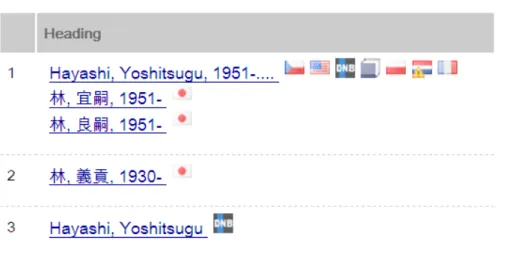
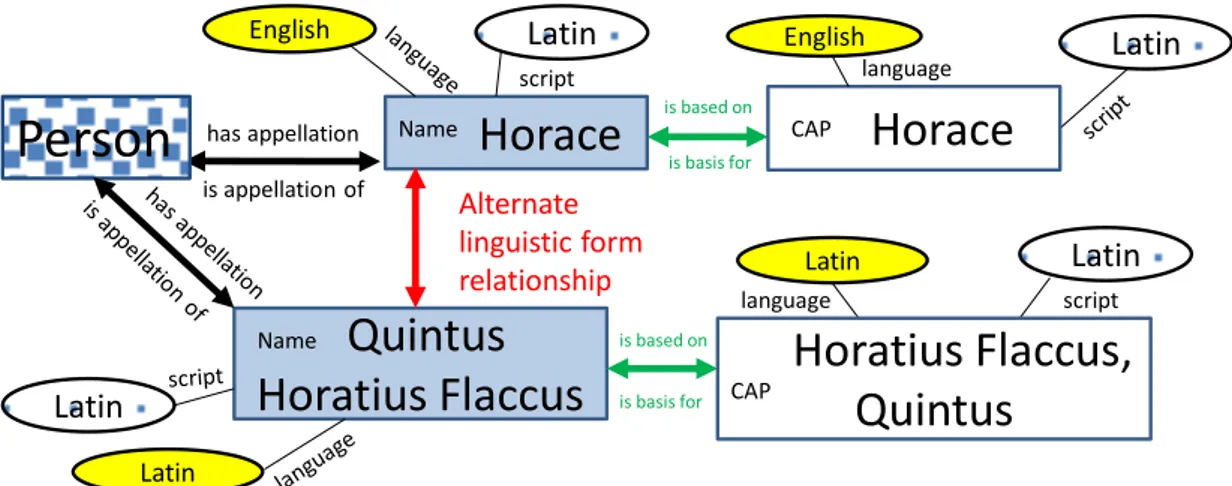
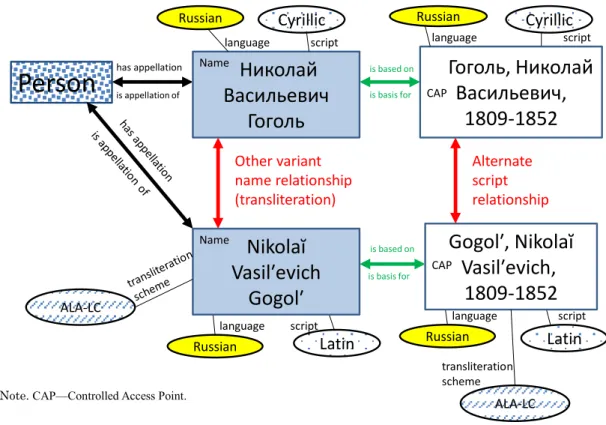
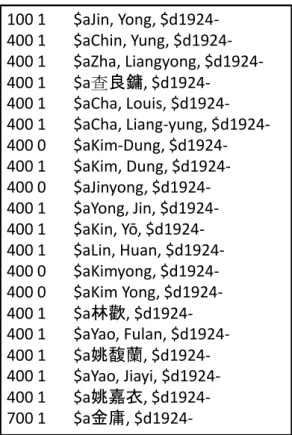
Dokumen terkait
Tugas akhir ini berkaitan dengan mata kuliah Konstruksi dan Per- encanaan Perangkat Lunak dan juga Pemrograman Integratif un- tuk benchmarking Sosial Media Pemerintah Daerah
Selain komentar positif yang ditemukan dapat mempengaruhi pembuatan keputusan dari konsumen, citra merek juga menjadi pertimbangan penting karena dengan terpenuhinya
Sesuai ketentuan Dokumen Pengadaan Pekerjaan Konstruksi Pasca Kualifikasi dengan metode pelelangan umum BAB III E.29.1 Pembuktian Kualifikasi terhadap peserta yang
Penelitian yang dilakukan di Desa Andongsari Kecamatan Ambulu Kabupaten Jember bertujuan untuk mengetahui: (a) faktor-faktor yang mempengaruhi pengambilan keputusan
[r]
2014 tentang Perubahan Atas Peraturan Daerah Provinsi Bengkulu Nomor 2 Tahun 2011 tentang Pajak Daerah Provinsi Bengkulu, perlu menetapkan Peraturan Gubernur
Berdasarkan hasil Keputusan Rapat Umum Pemegang Saham Tahunan (RUPST) yang diselenggarakan pada tanggal 21 April 2016 yang salah satu agendanya adalah pengangkatan anggota
Permainan peran dilaksanakan secara spontan. Pada awalnya banyak siswa yang masih bingung memainkan perannya atau bahkan tidak sesuai dengan peran yang seharusnya
